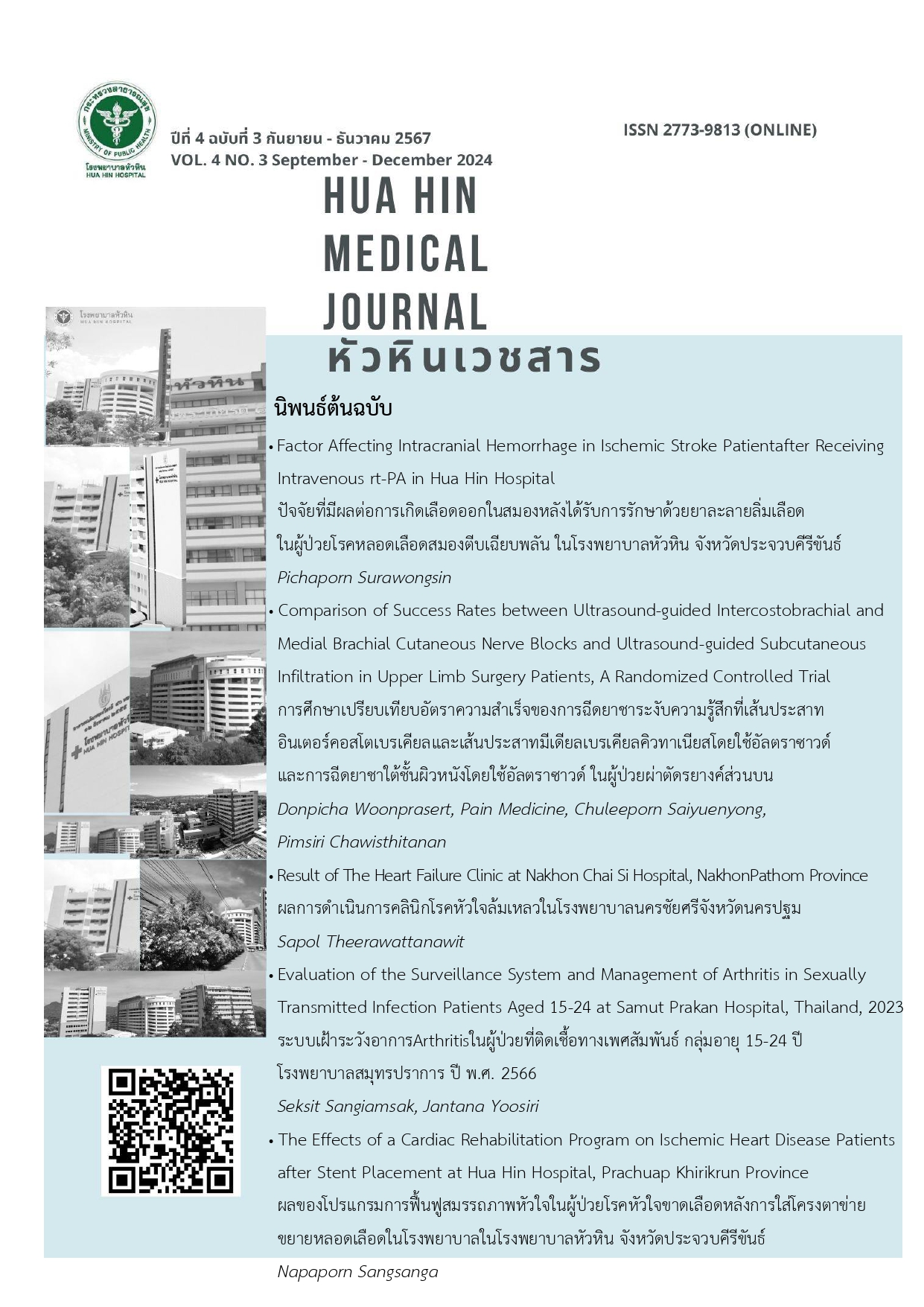Comparison of Success Rates between Ultrasound-guided Intercostobrachial and Medial Brachial Cutaneous Nerve Blocks and Ultrasound-guided Subcutaneous Infiltration in Upper Limb Surgery Patients, A Randomized Controlled Trial
Keywords:
Intercostobrachial and medial brachial cutaneous nerves block;, Ultrasound-guidance;, Upper limb surgeryAbstract
Background: The intercostobrachial and medial brachial cutaneous nerves can be anesthetized to block sensation in the inner upper arm either through subcutaneous infiltration or direct nerve injection. However, there have been no studies comparing the success rates between ultrasound-guided selective nerve block and subcutaneous infiltration for anesthetizing these nerves.
Objective: To compare the success rate of numbness at the inner upper arm between ultrasound-guided intercostobrachial and medial brachial cutaneous nerves block and ultrasound-guided subcutaneous infiltration in upper limb surgery patients. Additionally, the onset time of anesthesia between the two techniques was evaluated.
Methods: This randomized single-blinded controlled trial was conducted on 18 patients undergoing upper limb surgery at Samut Sakhon Hospital. Patients were selected based on specific criteria and randomly divided into two groups, each with 9 participants. General demographic data were collected. Sensory testing of the inner upper arm at 4 locations was conducted every 5 minutes for a total of 20 minutes after the injection. The number of patients experiencing numbness after local anesthetic injection was compared using the Chi-square test.
Result: The success rate of the intercostobrachial and medial brachial cutaneous nerve block group was 88.9% [95%CI 51.8, 99.7], which was higher than the subcutaneous infiltration group (66.7% [95%CI 29.9, 92.5]), although the difference was not statistically significant (P=0.257). However, the onset time for complete numbness at all four locations was significantly faster in the nerve block group (P<0.05). In the nerve block group, 87.5% of patients achieved complete numbness within 0-5 minutes, compared to 33.3% in the subcutaneous infiltration group.
Conclusion: The ultrasound-guided intercostobrachial and medial brachial cutaneous nerve block tended to have a higher success rate and faster onset of anesthesia compared to subcutaneous infiltration.
References
Lopera-Velásquez LM, Restrepo-Garcés C. Ultrasound and nerve stimulation-guided axillary. Colomb. J. Anesthesiol. 2016 Jan.;44(1):30-5.
Satapathy AR, Coventry DM. Axillary Brachial Plexus Block. Anesthesiology Research and Practice. 2011;2011:1–5.
Feigl G, Aichner E, Mattersberger C, Zahn PK, Avila Gonzalez C, Litz R. Ultrasound-guided anterior approach to the axillary and intercostobrachial nerves in the axillary fossa: an anatomical investigation. British Journal of Anaesthesia. 2018 Oct;121(4):883–9.
Samerchua A, Leurcharusmee P, Panjasawatwong K, Pansuan K, Mahakkanukrauh P. Cadaveric study identifying clinical sonoanatomy for proximal and distal approaches of ultrasound-guided intercostobrachial nerve block. Regional Anesthesia & Pain Medicine. 2020 Sep 14;45(11):853–9.
Magazzeni P, Jochum D, Iohom G, Mekler G, Albuisson E, Bouaziz H. Ultrasound-Guided Selective Versus Conventional Block of the Medial Brachial Cutaneous and the Intercostobrachial Nerves: A Randomized Clinical Trial. Reg Anesth Pain Med. 2018 Nov;43(8):832-837.
O'Rourke MG, Tang TS, Allison SI, Wood W. The anatomy of the extrathoracic intercostobrachial nerve. Aust N Z J Surg. 1999 Dec;69(12):860-4.
Loukas M, Hullett J, Louis RG Jr, Holdman S, Holdman D. The gross anatomy of the extrathoracic course of the intercostobrachial nerve. Clin Anat. 2006 Mar;19(2):106-111.
Thallaj AK, Al Harbi MK, Alzahrani TA, et al. Ultrasound imaging accurately identifies the intercostobrachial nerve. Saudi Med J 2015;36:1241–4.
Torre PAdela, Jones JW, Álvarez SL, et al. [Axillary local anesthetic spread after the thoracic interfacial ultrasound block - a cadaveric and radiological evaluation]. Rev Bras Anestesiol 2017;67:555–64.
Moustafa MA, Kandeel AA. Randomized comparative study between two different techniques of intercostobrachial nerve block together with brachial plexus block during superficialization of arteriovenous fistula. J Anesth 2018;32:725–30.
Jones MR, Novitch MB, Sen S, et al. Upper extremity regional anesthesia techniques: A comprehensive review for clinical anesthesiologists. Best Pract Res Clin Anaesthesiol. 2020;34(1):e13-e29.
Downloads
Published
How to Cite
Issue
Section
License
Copyright (c) 2024 Hua-Hin Hospital

This work is licensed under a Creative Commons Attribution-NonCommercial-NoDerivatives 4.0 International License.
บทความที่ได้รับการตีพิมพ์ในวารสารหัวหินเวชสาร เป็นลิขสิทธิ์ของโรงพยาบาลหัวหิน
บทความที่ลงพิมพ์ใน วารสารหัวหินเวชสาร ถือว่าเป็นความเห็นส่วนตัวของผู้เขียนคณะบรรณาธิการไม่จำเป็นต้องเห็นด้วย ผู้เขียนต้องรับผิดชอบต่อบทความของตนเอง







